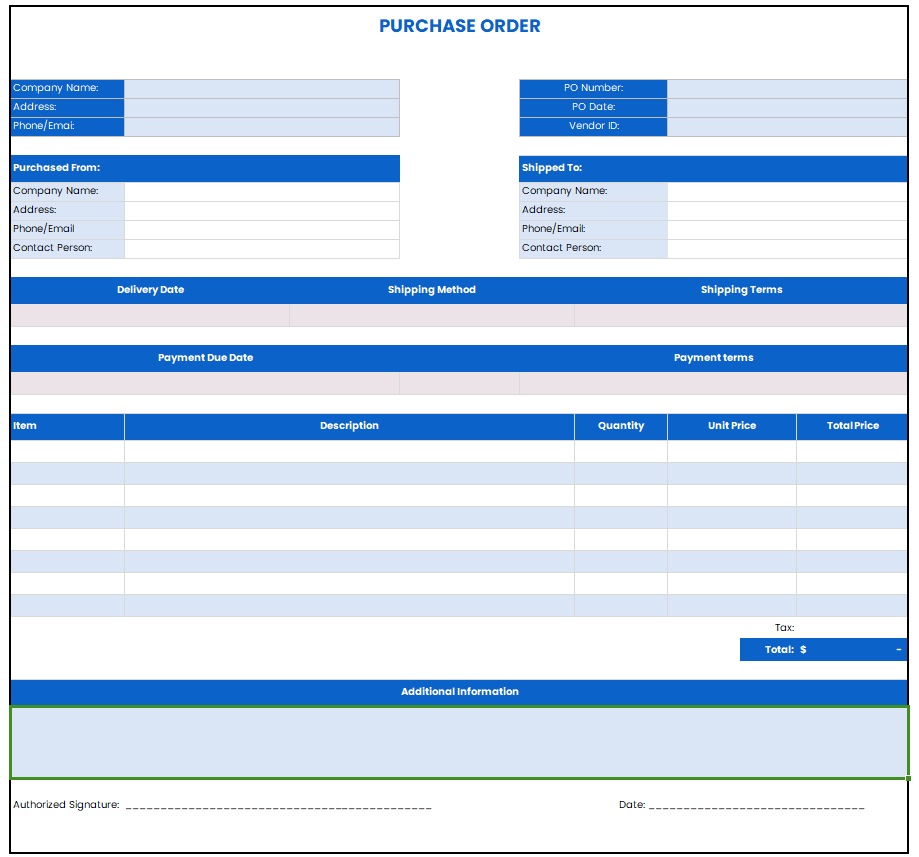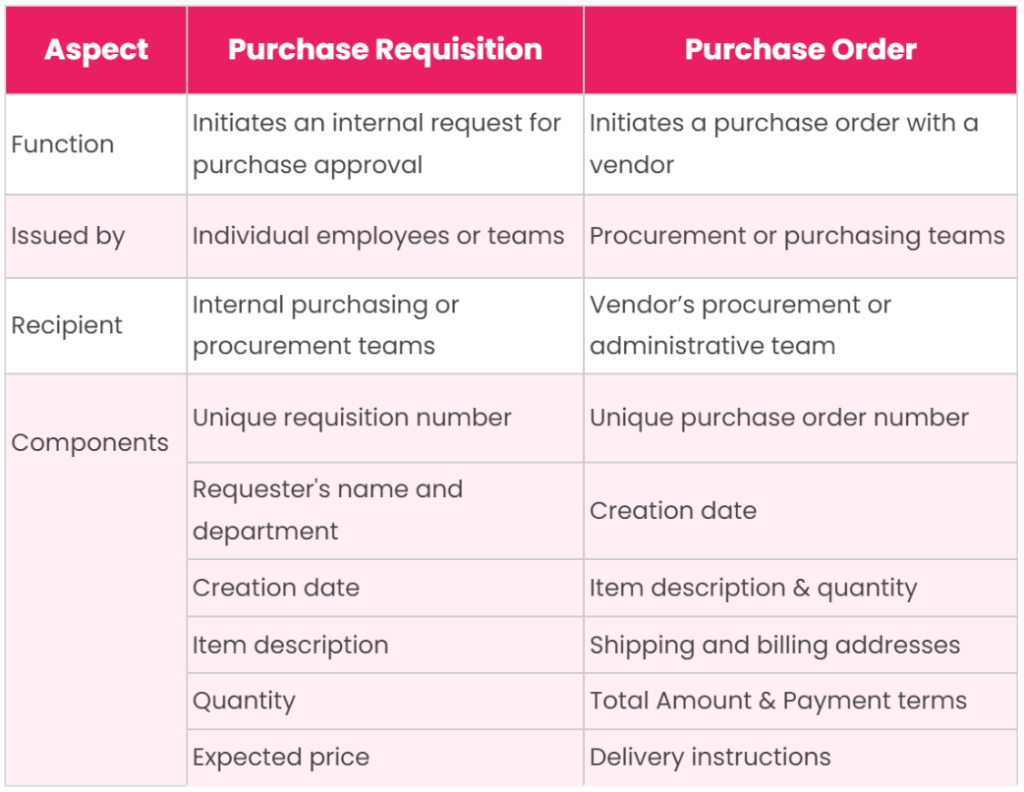Navigating procurement involves understanding key documents that play a pivotal role in the process. Among these, purchase requisition and purchase order stand out as critical elements, each serving distinct purposes in the procurement lifecycle. As organizations strive for efficiency and accuracy in their procurement operations, it becomes essential to grasp the fundamentals of purchase requisition vs purchase order.
In this blog, we’ll understand the difference between these two procurement essentials, explore their unique functions, and learn how to streamline the procurement process.
What is Purchase Requisition (PR)?
A Purchase Requisition (PR) is essentially a formal request made within an organization to procure goods or services. It serves as the initial step in the procurement process, initiated by an employee or department that identifies a need for certain items. The goal is to create a transparent and standardized method for acquiring necessary resources.
Components of Purchase Requisition
A purchase requisition usually contains:
- Department Name
- Requester Information
- Items Details
- Date of Request
- Requisition Number
- Reason for the Purchase
- Requested Delivery Date
- Estimated Purchase Cost
Why Purchase Requisition is Important for Businesses
A well-implemented Purchase Requisition process is the backbone of effective procurement management. Listed below are a few reasons why PR is important:
Control and Accountability: Purchase requisitions establish a structured process, promoting accountability and preventing unauthorized or unnecessary expenditures.
Budget Management: By including budget information, organizations can maintain control over their spending, preventing oversights and promoting financial responsibility.
Streamlined Workflow: The requisition process streamlines the workflow, minimizing delays and ensuring that the necessary approvals are obtained before procurement.
Vendor Relationships: PRs enable organizations to maintain positive relationships with vendors by providing clear and accurate information, reducing the likelihood of errors in orders.
Audit Trail: Purchase requisitions create a comprehensive audit trail, offering transparency and traceability for all procurement activities.
What is a Purchase Order (PO)?
A Purchase Order (PO) is essentially a formal document issued by a buyer to a seller, specifying the details of the products or services to be purchased. It serves as a contractual agreement that outlines the terms, conditions, quantities, and agreed-upon prices for the transaction. Think of it as a roadmap that guides the entire procurement process.
Components of Purchase Order
A purchase order usually contains:
- PO Number
- Issue Date
- Delivery Date
- Business Details
- Payment Terms
- Product Details
- Product Quantity
- Price per Unit
- Total Amount

Why Purchase Order is Important for Businesses
A well-defined Purchase Order process simplifies the communication between the buyer and seller. Listed below are a few reasons why PO is important:
Clarity and Avoidance of Disputes: By clearly outlining the terms and conditions, a Purchase Order minimizes the potential for misunderstandings or disputes between the buyer and seller.
Budget Control: Businesses can manage their budgets more effectively as Purchase Orders provide a predetermined framework for expenditures.
Efficient Record-Keeping: POs create a paper trail that aids in organized record-keeping, making audits and financial assessments more straightforward.
Streamlined Procurement Process: Purchase Orders facilitate a smoother purchasing process, helping businesses save time and resources.
Legal Protection: In case of disputes, a well-documented Purchase Order can serve as a legal document, providing protection for both parties involved.
Purchase Requisition Vs Purchase Order: Key Differences
In the realm of business transactions, two crucial documents play distinct yet interconnected roles: Purchase Requisitions and Purchase Orders. While they both contribute to the procurement process, they serve different purposes.
Purchase Requisitions act as internal requests within an organization. Teams utilize these documents to seek approval for the purchases they intend to make. Essentially, PRs serve as the initial step in the procurement workflow, ensuring that necessary approvals are obtained before proceeding with a purchase.
On the other hand, Purchase Orders are external documents dispatched by organizations to their vendors. These documents formalize the intent to buy and provide vendors with specific details regarding the products or services required. In essence, a PO serves as a contractual agreement between the buyer and the seller, outlining the terms and conditions of the purchase.

Role in Procurement Process: Purchase Requisition Vs Purchase Order
While a Purchase Requisition secures internal approval, a Purchase Order extends the procurement process to external stakeholders, creating a cohesive and organized workflow. The utilization of both documents ensures that purchases align with internal approvals and are seamlessly communicated to external vendors. It fosters transparency and efficiency in the procurement journey.
Understanding the distinct roles of Purchase Requisition and Purchase Order is a strategic imperative for organizations aiming to enhance their procurement processes and establish robust vendor relationships.
Optimizing your company’s procurement process holds advantages for all stakeholders. In the absence of well-defined rules and processes, valuable time is often lost on retrieving misplaced information or rectifying errors arising from mishandled paperwork.
A practical solution to enhance efficiency involves incorporating user-friendly automated solutions for purchase requisitions and purchase orders.
A Way Forward with Procure-to-Pay Automation
Peakflo’s procurement solution enables you to streamline the approval process for purchase requisitions and purchase orders, offering numerous advantages over manual and paper-based methods. The most significant benefits are time and cost savings achieved by eliminating repetitive time-intensive tasks.
The solution can seamlessly integrate with other software, allowing teams from different departments to create requisitions more efficiently. Afterward, requisitions are automatically directed to the concerned approver. It further simplifies the procurement process.
Additionally, gain visibility into all related internal and external communication and audit trails in a unified space, as opposed to scattered papers or files on different computers.
Furthermore, it simplifies budget management for your company. Track your company’s budget in real-time from PR creation to bill payments. If a requisition exceeds a team’s budget, it is automatically highlighted and the solution instantly notifies the budget owner.
For teams seeking to streamline their purchase requisition to purchase order process, Peakflo’s Procure-to-Pay proves to be a highly effective solution.










![Why AI Sales Calls Are Making Good Sales Reps Even Better [2025 Guide] ai sales calls](https://blog.peakflo.co/wp-content/uploads/2025/09/65168cf6-3001-4733-8cbc-12d5684cf449-218x150.webp)




































